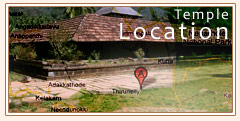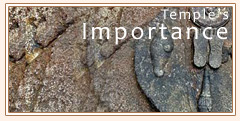Importance
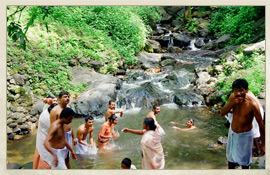
Thirunelli is a unique place where one would experience communion of
nature with the divine forces. Thus it becomes an ideal spot for
pilgrimage as well as an idyllic location for enjoying the nature’s
bounties. Sunrise on the Brahamagiri at the back drop of Thirunelli
temple is an enthralling sight. Papanasini, Pinnappara,
Panchatheertham and Gunnika Temple are the other places of importance for the
pilgrims who come with ardour and devotion.
It is a wild stream that originates from the Brahmagiri Hills which later joins River Kalindi. It is almost 400 mtrs away from the temple, on its
Papanasini
It is a wild stream that originates from the Brahmagiri Hills which later joins River Kalindi. It is almost 400 mtrs away from the temple, on its
western side. Literally it means, extinguisher of sins. It is
believed that River Ganga and River Saraswathi join in Papanasini.
Therefore Papanasini is called the Southern Kashi. A ritual dip in
Papanasini is believed to wash one away, of all worldly sins committed
in a life time. If we immerse the ashes of the dead in Papanasini, it
is equivalent to that of doing Karmas(Rituals ) in Gaya. At Papanasini
there is a sacred rock called Pinnappara where ritual offerings to the
spirits of the departed are made (known as bali). People believe that
Parasurama, the famous incarnation of Lord Vishnu visited Thirunelli
and performed last rites at the death of his father sage Jamadagni. He
also took immersion in the Papanasini to wipe away sins committed
owing to the annihilation of Kshatriyas. The ashes of Rajiv Gandhi was
immersed in Papanasini in 1991.
Papanasini (destroyer of sins) has an interesting story to reveal.
When Brahma was consecrating Vishnu’s idol Garuda (the carrier of
Vishnu) reached over the sky, above the installation venue with the
Amrit Kumbha (pot of nectar). During Garuda’s circling over, a drop of
Amrit fell on the stream, which provided purifying power to the water
in the stream. After that incident the stream came to be called
Papanasini. Papanasini later joins in River Kalindi which is a
tributary of River Kabani which later joins in River Kaveri.
This rock is supposed to be the bone of an asuran (demon) named Pazhana-bhedi, who was killed by Vishnu. At the time
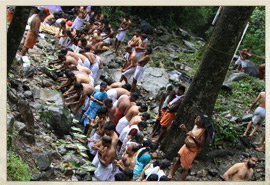
The steps at the back of the temple actually leads to the tank Panchteertham. It is believed that Panchteertham, at one point of time was a meeting point of five rivers. Hence its sacred importance was immense. But today most of the water has dried up and the only remaining attraction is the footsteps of Vishnu, Vishnupad. It is the image of a footprint on a boulder in the middle of the tank.
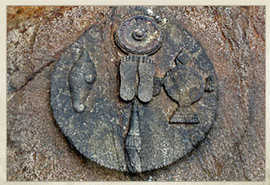
Pinnappara
This rock is supposed to be the bone of an asuran (demon) named Pazhana-bhedi, who was killed by Vishnu. At the time

of his death he prayed to Vishnu that his body be converted into a rock extending from
Thirunelli to Gaya and divided into three parts fit for the
performance of offerings for the departed, at (1)Thiurnelli
representing his foot, (2)Godavari representing the middle part, and
(3)Gaya representing the head. Offerings at any of these three places
are supposed to have special benefits in producing happiness and in
the propitiation of the spirits. In Thirunelli ritual offerings to the
spirits are made at Pinnappara, especially on the New Moon days of the Malayalam months Karkkidakom, Thulam and Kumbham.
It is believed that Sri Rama and his brother Lakshmana performed the ‘pithrukarma’ of their father King Dasaratha, standing on this rock.
It is believed that Sri Rama and his brother Lakshmana performed the ‘pithrukarma’ of their father King Dasaratha, standing on this rock.
Panchatheertham
The steps at the back of the temple actually leads to the tank Panchteertham. It is believed that Panchteertham, at one point of time was a meeting point of five rivers. Hence its sacred importance was immense. But today most of the water has dried up and the only remaining attraction is the footsteps of Vishnu, Vishnupad. It is the image of a footprint on a boulder in the middle of the tank.

Gunnika Temple
As you walk from Thirunelly temple to Papanasini along the riverbank , somewhere midway on your left, a small bridge appears. Cross this to go to a cave temple called Gunnika temple dedicated to lord Siva. Legend is that a fruit ( again Nelli fruit ) plucked by a pilgrim was turned into a Phallus (Shiva linga), as he was finishing bath in the Papanashini.
